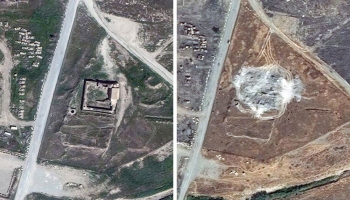Guardian: Exclusive: Suspect in New York and New Jersey bombings spent three weeks in 2011 at Kaan Kuwa Naqshbandi madrassa, source says, amid questions of terrorism links
Ahmad Khan Rahami, the man suspected of placing bombs in New York and New Jersey last weekend, spent time in a religious seminary in Pakistan closely associated with the Afghan Taliban, according to a government official.
The 28-year-old, who was born in Afghanistan but became a US citizen, spent time at the Kaan Kuwa Naqshbandi madrasa on his two visits to Pakistan, a security official working for the government of Balochistan province told the Guardian.
Rahami spent three weeks in 2011 receiving “lectures and Islamic education” at the school in Kuchlak, a dusty cluster of villages 20km north of Quetta, the provincial capital of Balochistan, he said.
Kuchlak is a well-known hub for the Taliban, the Islamist movement that has waged a 15-year insurgency against local and Nato forces in nearby Afghanistan. It is home to many madrasas, the seminaries intimately linked with the Taliban, originally a movement of religious students.
US officials have revealed basic details about Rahami’s two visits to Pakistan, the first in 2011 when he spent a couple of months in Quetta and got married and almost a year in 2013 when he also made a car journey to Afghanistan.
But very little information has emerged from inside Pakistan about what Rahami did during his visits.
Related reading: U.S. State Dept/Pakistan Bureau of Democracy, Human Rights, and Labor
The government official, who did not wish to be named because he was speaking about a highly sensitive subject, said Pakistani security agencies have tried to “hide all the details of his visits to Quetta” and keep as much information as possible out of the media.
Rahami, he said, also visited other sensitive areas in the province, including Surkhab and Nushki, where former Taliban leader Mullah Akhtar Mansoor was killed by a US drone in May.
Pakistan has long been accused of playing a “double game” with the US, both supporting the Nato counterinsurgency in Afghanistan and allowing the Taliban to use its territory a vital rear base.
A western expert on the Taliban said Abdul Samad, the Afghan owner of the Kuchlack madrasa, was an important local figure.
“The madrasa is a place where you have multiple Afghan Taliban going there and hanging out in [Samad’s] court, as well as active ISI officers,” he said, referring to the Inter-Services Intelligence (ISI) directorate, an army-run spy agency.
“Samad is the kind of person who should have been shut down long ago but enjoys a high degree of protection,” he said.
Despite being part of the mystical, Sufi strain of Islam, which many hardliners abhor, Samad is highly respected by the movement, he said.
A Karachi-based cleric told the Guardian the school was a sizeable operation, with more than 200 students.
Despite several attempts to reach Samad for comment, the Guardian was unable to make contact with the madrasa.
Although the Taliban’s leadership is often described as the “Quetta Shura” many analysts consider Kuchlak to be the actual command centre for many senior members of the movement.
The Taliban’s white flags have been reportedly seen flying in the town’s graveyards and Shahbaz Taseer, a Pakistani kidnapped by militants in Lahore in 2011 and held for more than four years, was released in Kuchlak in March by the Taliban.
Rahami’s father Mohammad Rahami has said his son had grown increasingly interested in Islamist movements, watching Taliban and al-Qaida videos, and listening to their poetry. Rahami had also shown sympathy towards the Taliban, a former employer said.
Related reading: San Bernardino/ The Islamic Center of Riverside or Brooklyn
Given the Taliban has long avoided entanglement in international jihad, insisting it is interested only in forcing foreign troops out of Afghanistan, it is unlikely Rahami was operating under instruction when he planted his bombs. A notebook found on Rahami when he was captured after a shootout on Monday suggests he may have been inspired by the Islamic State group.
But the claim Rahami attended an important Taliban-sympathising madrasa could be embarrassing for Pakistan at a time the country is under intense international criticism, not least from India, which accused Pakistan this week of hosting “the Ivy League of terrorism”.
Anwar-ul-Haq Kakar, a spokesman for the Balochistan government, said that because more than 1 million Afghan refugees lived in the province it was “difficult to know what sort of activity is being conducted by some individuals”.
“Filtering out the terrorist influences in such a huge community is a very difficult task,” he said.
Nor could the government be expected to be aware of a US traveller such as Rahami, who has “deep links in the host community”.
“If he was not spotted by the CIA and FBI or Homeland Security, then this shows that it is really global problem,” he said.
*** The basis for the swap of the Taliban 5 out of Guantanamo for Bowe Bergdahl? It all seems Qatar was the core and interlocutor for the Taliban. Clinton and Obama managed the failed process.
Negotiations with the Taliban initiated by the United States were for getting all factions to talk to each other. Why bother talking to the Taliban? The answer is that, as both President Barack Obama and former Secretary of State Hillary Clinton made clear while I served as special representative, the war in Afghanistan is going to end politically and we would either shape that end or be shaped by it. If there is ever to be peace in Afghanistan, Afghans will need to talk to other Afghans about the future of Afghanistan. Since the Taliban today officially refuses to talk to Kabul’s representatives, getting to these talks might require a US effort to help open the door.
Those US-Taliban talks, which lasted from mid-2011 to March 2012, ultimately failed. While many details rightly remain classified, here are three of the lessons I learned sitting across the negotiating table from the Taliban that may be helpful to those who may seek to reopen the dialogue with them or others who need to talk to an insurgent group in some present or future conflict:
Set clear conditions and moral guidelines and stick to them. These need not be preconditions. Indeed, before talks with the Taliban began, Secretary Clinton made clear that while the US had no preconditions for talking to them, Washington would support reconciliation with only those insurgents who met three important end conditions: Break with al Qaeda, end violence, and live inside an Afghan Constitution that guarantees the rights of all individuals, especially women. Force must be backed by diplomacy, and diplomacy must be backed by force. Talking with the Taliban was part of the larger “diplomatic campaign” Secretary Clinton launched in 2011 to complement the military surge President Obama had ordered in 2009. This diplomatic campaign tried to harness all of the instruments of non-military power to support Afghanistan, such as development assistance, private-sector investment and support for civil society. As part of this effort, we organized international meetings in Istanbul, Bonn, Chicago and Tokyo, at which nations and international organizations pledged future political and material support for Afghanistan. These conferences were also designed to send the Taliban clear messages that the international community was committed to supporting Afghanistan beyond 2014. More here.
Last item of note: In part from Newsweek: The groups targeting the state follow the Deobandi interpretative tradition of Islam. This is important because this means that they share a significant common organizational infrastructure. For example, they rely on mosques and madrassas that adhere to the Deobandi tradition of Islam. When 9/11 happened and Pakistan was forced to work with the Americans, these Deobandi groups were furious. Many of these groups came to know Al-Qaeda through their association with the Taliban in Afghanistan. [The Afghan Taliban emerged from Deobandi madrassas in Pakistan.] And these Deobandi groups were furious that the Pakistani state was aiding the overthrow, not only of the Taliban government, but the only government in the world that was exercising a Deobandi version of Sharia [Islamic law]. After 9/11…[some] of these Deobandi groups began fracturing and disobeying the [Pakistani] state. That’s when the insurgency began. Over time these Deobandi organizations began calling themselves the Pakistani Taliban.
 1930
1930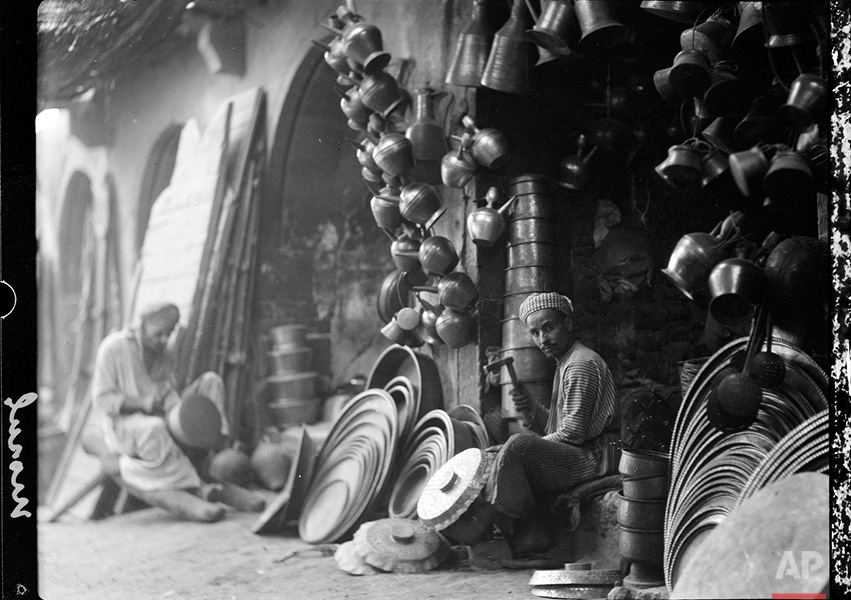
 This combination of two photographs shows a 1932 image of men on a lorry on the road to Mosul, northern Iraq, from the Library of Congress, top, and fighters from the Islamic State group parading in a commandeered Iraqi security forces armored vehicle down a main road in Mosul on Monday, June 23, 2014. (AP Photo) License this photo
This combination of two photographs shows a 1932 image of men on a lorry on the road to Mosul, northern Iraq, from the Library of Congress, top, and fighters from the Islamic State group parading in a commandeered Iraqi security forces armored vehicle down a main road in Mosul on Monday, June 23, 2014. (AP Photo) License this photo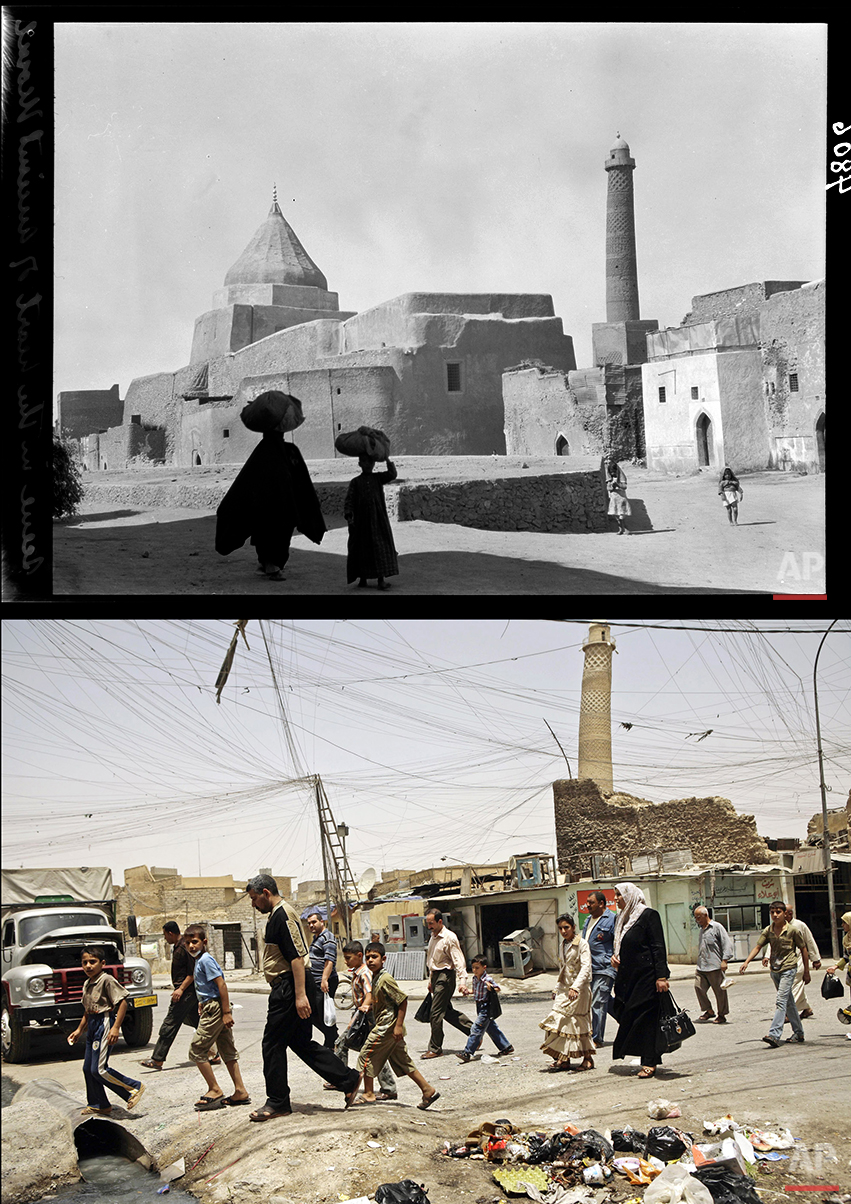 This combination of two photographs shows a 1932 image of the Crooked Minaret mosque next to a Yazidi shrine in Mosul, northern Iraq, from the Library of Congress, top, and the same site, without the shrine, on June 8, 2009. In July, Islamic State militants failed to destroy the 840-year old Crooked Minaret that leans like Italy’s Tower of Pisa when residents sat on the ground and linked arms to form a human chain. (AP Photo) License this photo
This combination of two photographs shows a 1932 image of the Crooked Minaret mosque next to a Yazidi shrine in Mosul, northern Iraq, from the Library of Congress, top, and the same site, without the shrine, on June 8, 2009. In July, Islamic State militants failed to destroy the 840-year old Crooked Minaret that leans like Italy’s Tower of Pisa when residents sat on the ground and linked arms to form a human chain. (AP Photo) License this photo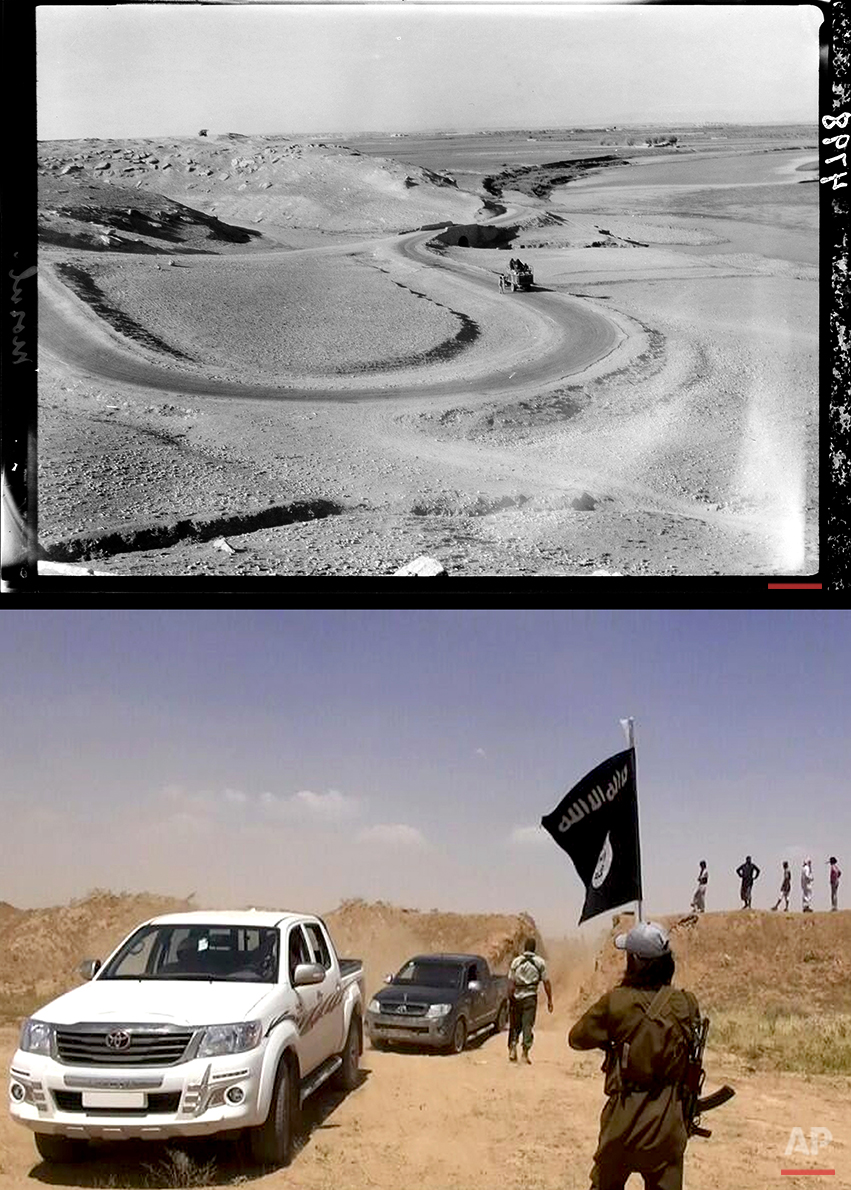 This combination of two photographs shows a 1932 image of a lorry on the road south of Mosul, Iraq, from the Library of Congress, top, and an image posted on a militant news Twitter account on Thursday, June 12, 2014 showing militants from the Islamic State group removing part of the soil barrier on the Iraq-Syria borders and moving through it. (AP Photo) License this photo
This combination of two photographs shows a 1932 image of a lorry on the road south of Mosul, Iraq, from the Library of Congress, top, and an image posted on a militant news Twitter account on Thursday, June 12, 2014 showing militants from the Islamic State group removing part of the soil barrier on the Iraq-Syria borders and moving through it. (AP Photo) License this photo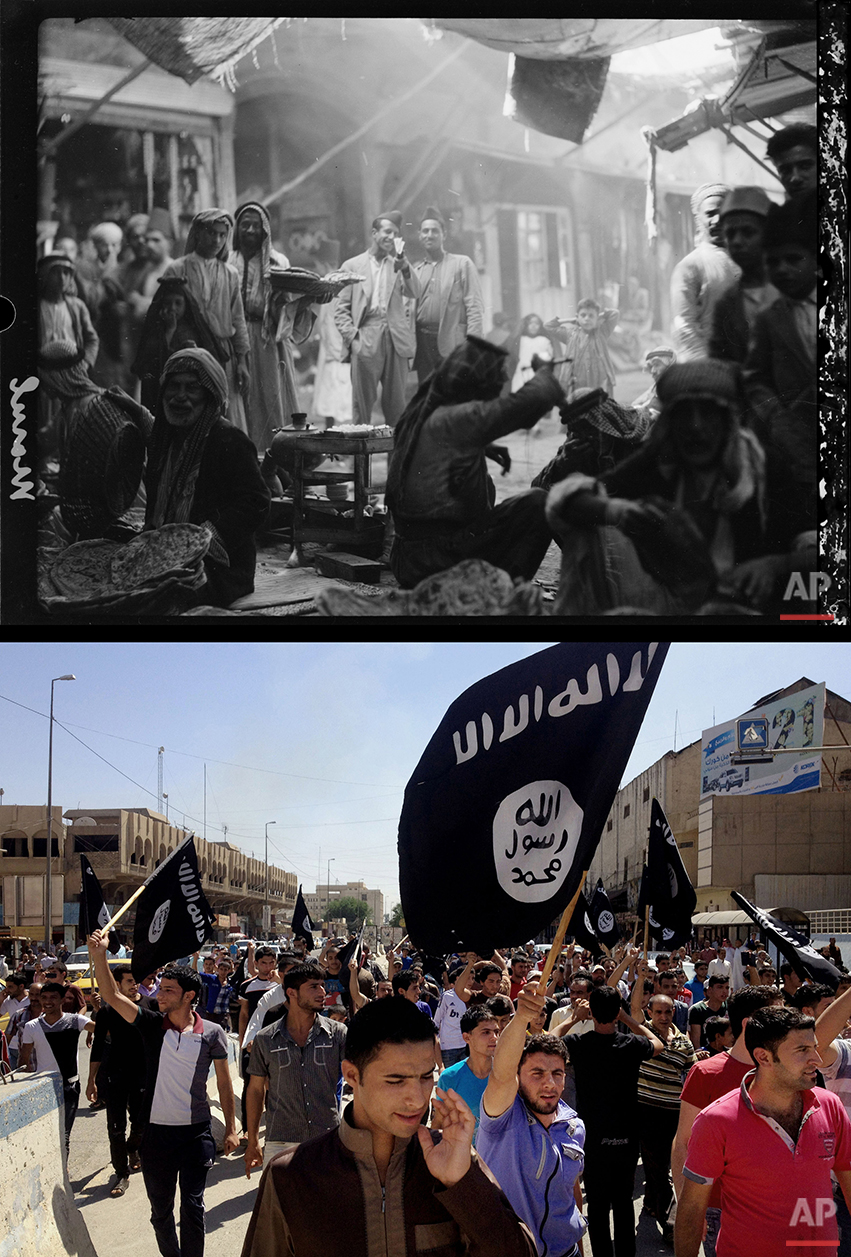 This combination of two photographs shows a 1932 image of Iraqis in the market in Mosul, northern Iraq, from the Library of Congress, top, and demonstrators chanting pro-Islamic State group slogans as they carry the group’s flags in front of the provincial government headquarters in Mosul on Monday, June 16, 2014. (AP Photo) License this photo
This combination of two photographs shows a 1932 image of Iraqis in the market in Mosul, northern Iraq, from the Library of Congress, top, and demonstrators chanting pro-Islamic State group slogans as they carry the group’s flags in front of the provincial government headquarters in Mosul on Monday, June 16, 2014. (AP Photo) License this photo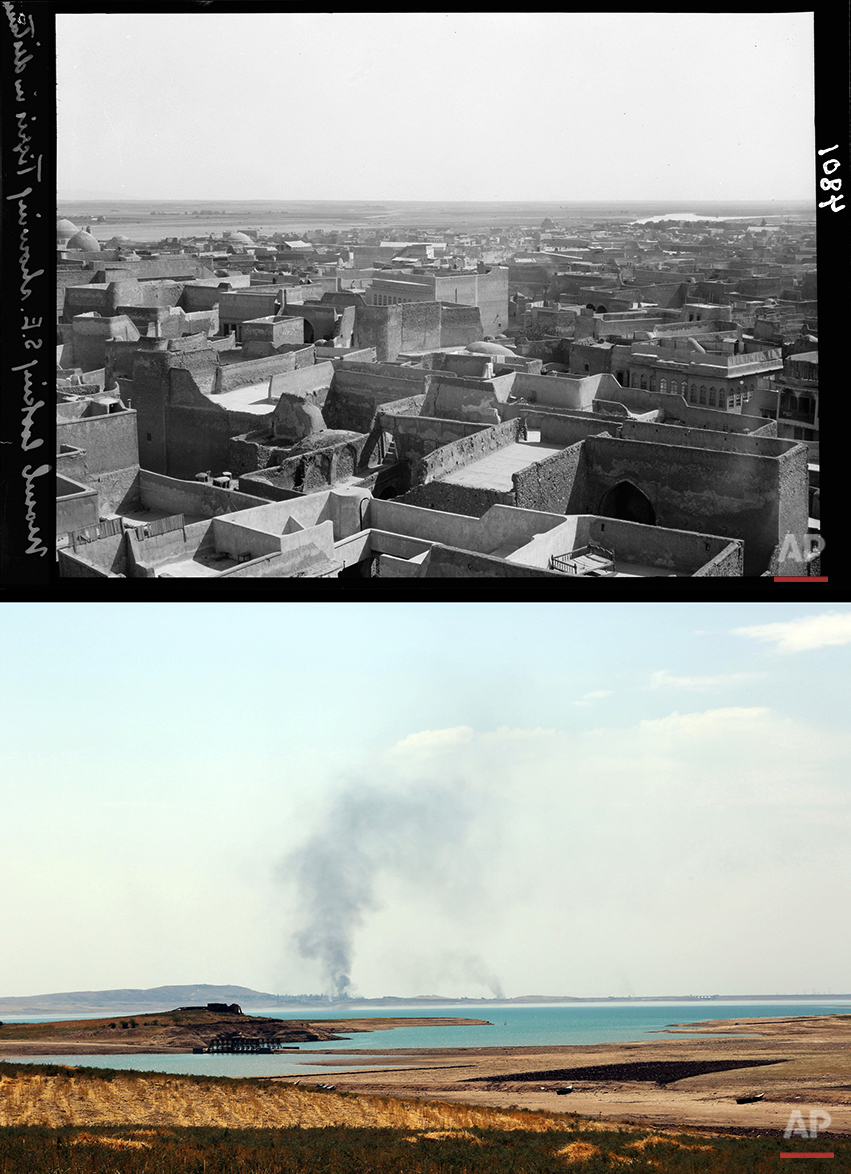 This combination of two photographs shows a 1932 image of the Tigris River stretching out in the distance as seen from Mosul, northern Iraq from the Library of Congress, top, and a file photo of smoke rising during airstrikes targeting Islamic State militants at the Mosul Dam on Monday, Aug. 18, 2014. (AP Photo) License this photo
This combination of two photographs shows a 1932 image of the Tigris River stretching out in the distance as seen from Mosul, northern Iraq from the Library of Congress, top, and a file photo of smoke rising during airstrikes targeting Islamic State militants at the Mosul Dam on Monday, Aug. 18, 2014. (AP Photo) License this photo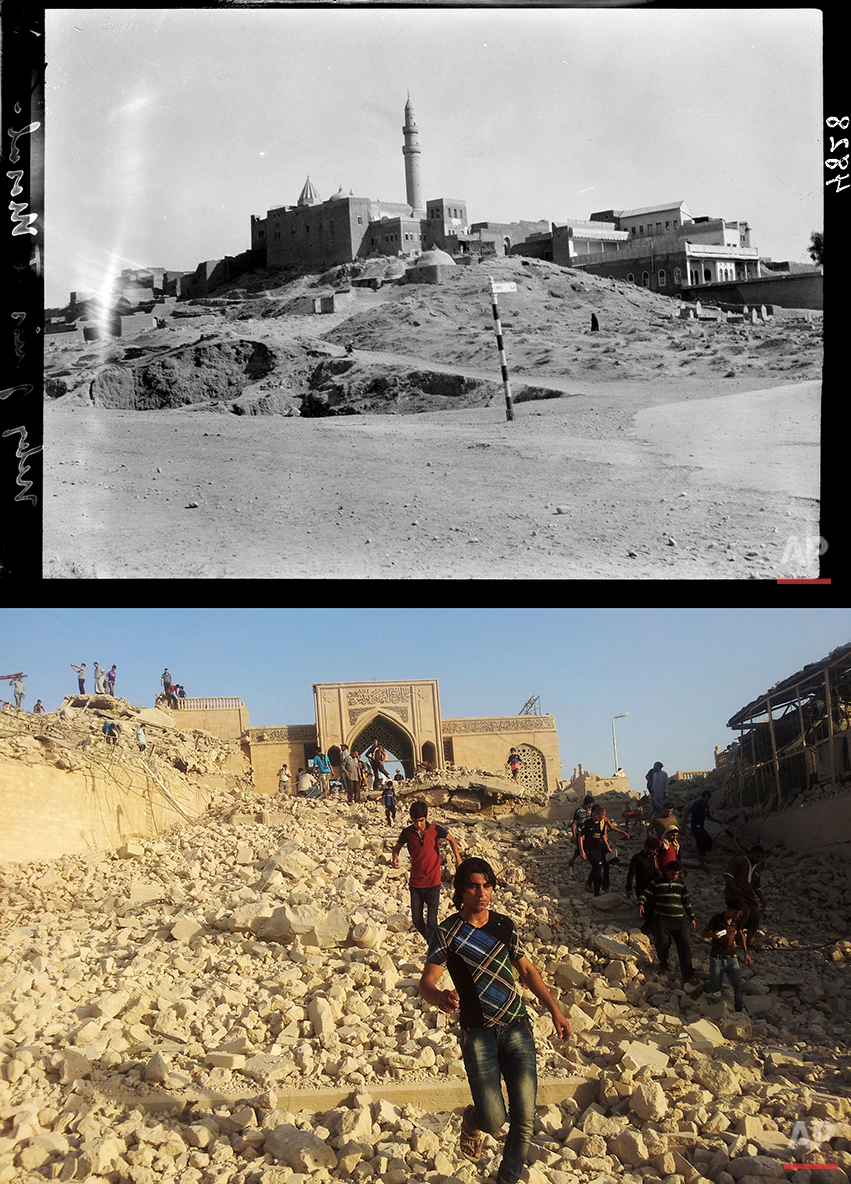 This combination of two photographs shows a 1932 image taken during the autumn of Nebi Yunis, the tomb of the prophet Jonah, in Mosul, northern Iraq, from the Library of Congress, top, and Iraqis walking in the rubble of the revered Muslim shrine after it was was destroyed on Thursday, July 24, 2014 by militants who overran the city in June and imposed their harsh interpretation of Islamic law. (AP Photo) License this photo
This combination of two photographs shows a 1932 image taken during the autumn of Nebi Yunis, the tomb of the prophet Jonah, in Mosul, northern Iraq, from the Library of Congress, top, and Iraqis walking in the rubble of the revered Muslim shrine after it was was destroyed on Thursday, July 24, 2014 by militants who overran the city in June and imposed their harsh interpretation of Islamic law. (AP Photo) License this photo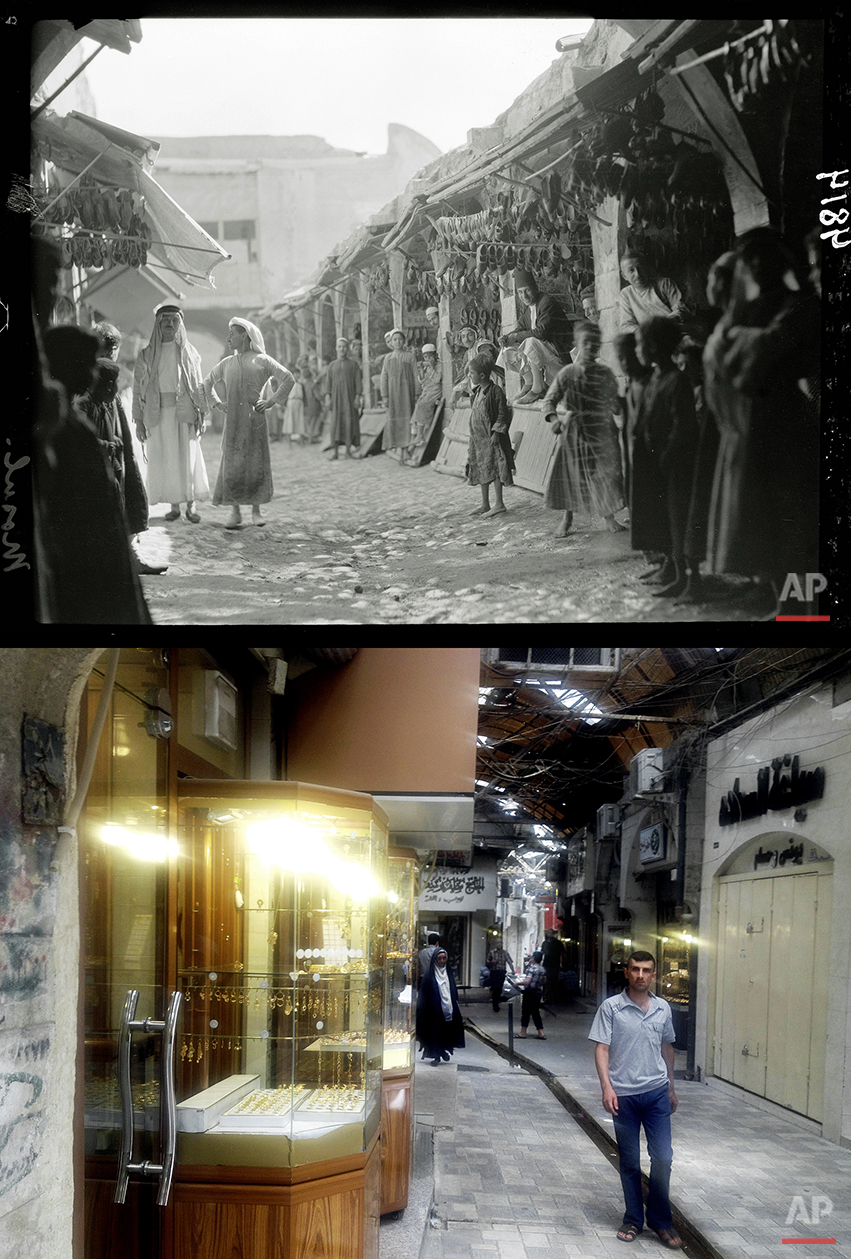 This combination of two photographs shows a 1932 image of Iraqi vendors and customers in the shoe market in Mosul, northern Iraq from the Library of Congress, top, and a Monday, July 7, 2014 file photo of a man walking in a market, nearly a month after Islamic militants took over the country’s second largest city. (AP Photo) License this photo
This combination of two photographs shows a 1932 image of Iraqi vendors and customers in the shoe market in Mosul, northern Iraq from the Library of Congress, top, and a Monday, July 7, 2014 file photo of a man walking in a market, nearly a month after Islamic militants took over the country’s second largest city. (AP Photo) License this photo This combination of two photographs shows a 1932 image of a main street in Mosul, northern Iraq, from the Library of Congress, top, and militants parading down a main road in Mosul, posted on a militant Twitter account on Wednesday, June 11, 2014, which has been authenticated based on its contents and other AP reporting. (AP Photo) License this photo
This combination of two photographs shows a 1932 image of a main street in Mosul, northern Iraq, from the Library of Congress, top, and militants parading down a main road in Mosul, posted on a militant Twitter account on Wednesday, June 11, 2014, which has been authenticated based on its contents and other AP reporting. (AP Photo) License this photo
